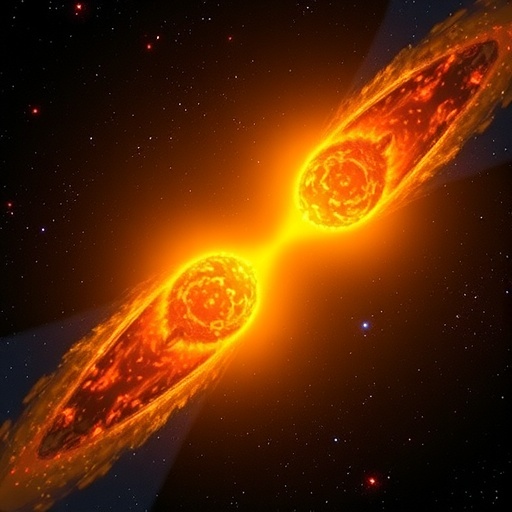The complexities of understanding the formation of planetary systems in distant galaxies have long posed a formidable challenge to astronomers. Conducting meticulous comparisons to unravel the cosmic puzzle of dwarf galaxies, supermassive black holes, or exotic exoplanets like “hot Jupiters” often requires considerable time and effort, further complicated by the vastness of space and the relative proximity of celestial objects. However, the advent of new research from Yale offers a promising avenue to uncover the nuances of planetary formation through the identification of “twin” planetary systems.
In their study, researchers from Yale University meticulously explored the characteristics of binary star systems—two stars that orbit each other, often born from the same molecular cloud and roughly at the same time. This research endeavor fundamentally aims to assess whether these binary systems reveal similarities in the planets that orbit their respective stars, thereby drawing analogies to the study of human twins within the biological realm. The team observed that specific spatial orientations of twin star systems might serve as significant indicators of planetary formation mechanisms.
According to Malena Rice, an assistant professor of astronomy at Yale and the senior author of the study, the configuration of certain binary star systems appears uniquely conducive to comparative studies. Twin star configurations, particularly when viewed edge-on from Earth, may provide a clearer lens through which to analyze the processes involved in planetary formation. Just as physicians use the insights gained from studying human twins to unravel genetic and environmental influences on health, astronomers can leverage the similarities and differences between twin star systems to enhance our understanding of planetary evolution.
Rice’s research presents a groundbreaking hypothesis that could revolutionize the scientific community’s approach to planetary studies. Traditional methodologies often lack reliable comparative samples, leaving astronomers to postulate various theories on how planets form. However, by examining edge-on binary systems, researchers may finally possess a means of acquiring data that allows for direct comparisons of planetary characteristics across multiple systems.
Central to the study’s findings was the discovery of an unexpectedly high number of binary systems with aligned orbits—an arrangement where both binary stars and their planets orbit in the same geometrical plane. This phenomenon suggests that the gravitational influence of the companion star may stabilize planetary orbits and mitigate sharp climate shifts that could compromise the potential for life. Such stability offers a fertile ground for investigating the broader conditions necessary for habitable environments beyond our solar system.
The alignment of these stars not only plays a role in stabilizing their planetary systems but also enhances the detectability of new planets. Researchers identified nearly 600 edge-on binary star systems, utilizing data from the European Space Agency’s Gaia DR3 catalogue, which catalogs high-precision stellar astrometry. By measuring the orbits of these binary stars, the study’s team was able to simulate the expected planetary configurations around each star, establishing a roadmap for future planet-hunting missions.
This research is particularly significant as it provides a predictive framework for where astronomers might find new planets with greater efficiency. By narrowing down the search to specific edge-on binary systems, astronomers can focus their observing efforts on high-probability zones within the universe, thus increasing the likelihood of discovering and characterizing new exoplanets. This advancement has far-reaching implications for our understanding of the frequency and diversity of planetary systems and their potential for hosting life.
With this approach, astronomers now have the means to not only identify new planets but also conduct comparative studies between planetary systems birthed from the same cosmic cradle. This pioneering work enables a robust control sample—one planetary system can provide insights into another, both of which originated together. This ability to draw parallels between planetary systems enhances the potential for unveiling the fundamental laws governing planet formation.
As the research unfolds in the pages of The Astrophysical Journal Letters, it further solidifies Yale University’s position as a leader in astronomical research. The collaborative effort included inputs from Joseph Hand, an undergraduate from the University of Kansas who conducted research under the auspices of the Dorrit Hoffleit Undergraduate Research Scholarship, and Konstantin Gerbig, a Ph.D. candidate, underscoring the importance of fostering academic inquiry at all levels of education.
The funding of this substantial research endeavor stemmed from support provided by both the Dorrit Hoffleit Undergraduate Research Scholarship program and the Heising-Simons Foundation, demonstrating a broader commitment to advancing scientific knowledge in astrophysics. As more insights spring from this research, the astronomical community pushes further into the depths of our understanding of how planets form in the universe.
The implications of this study resonate beyond academic circles; they touch on our intrinsic curiosity about the cosmos and the origins of life itself. The notion that similar planetary systems might exist side-by-side in the universe invokes a sense of wonder and possibility. Are there worlds where conditions are mirrored to those on Earth, ripe for exploration? Such inquiries are quintessential to the drive of science, pushing humanity to explore the stars.
In conclusion, this Yale study represents a significant leap forward in understanding planetary formation through the lens of twin star systems. By paving the way for detailed comparative studies within edge-on binary systems, researchers stand on the cusp of unlocking previously inaccessible knowledge about the origins of planets and their potential for sustaining life. As the search for exoplanets intensifies, this innovative methodology may reveal secrets of the universe that have eluded us for centuries, inviting us to question what life might exist beyond our own celestial neighborhood.
Subject of Research: Comparative Studies of Twin Planetary Systems
Article Title: New Yale Study Explores the Comparative Study of Twin Planetary Systems
News Publication Date: [Insert Date Here]
Web References: [Insert Web References Here]
References: [Insert References Here]
Image Credits: [Insert Image Credits Here]
Keywords
Twin Star Systems, Planetary Formation, Astronomy, Edge-on Configuration, Yale Research, Exoplanets, Comparative Study, Binary Stars, Astrophysical Insights.




